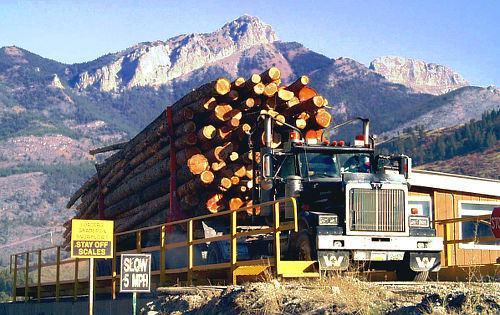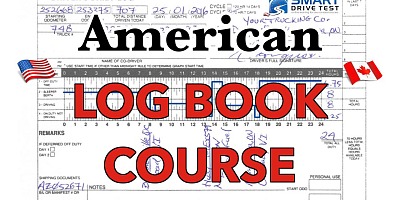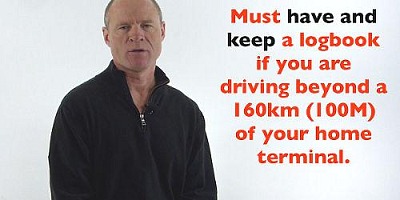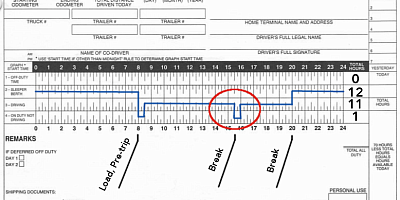As a CDL driver, you may not have to keep a log book.
Logbook Exempt | United States
Introduction
Hi there smart drivers, Rick with Smart Drive Test talking to you today about logbooks and exemption from keeping a log book in the United States of America.
This is for American drivers who are not required to keep a log book as per the rules for hours of service regulations in the United States.
Now these are a little bit complicated and there are some technical terms, which took me a little while to figure out and understand.
And hopefully I can clarify some of this for you and relay some of this information to you.
Don't Work the Day for Free:: DOT Weigh Scale Checklist |
||

• DID YOU KNOW? :: Bus & truck drivers are the only drivers that have their own police force (DOT, CVSE, MTO, etc.);• SMART :: There's a lot of paperwork you must produce for authorities at the weigh scale;• SELF-CONFIDENCE :: Bring all paperwork in one hit & impress the diesel bears! |
||
Because in most cases, it's you that gets the fine...NOT the company! |
So what we're going to do today - we're going to talk about logbook exemptions for those drivers who don't need to keep a log book; however, saying that, even though you don't need to keep a log book because you're following certain rules in the United States according to hours of service regulations, paperwork still has to be kept on the part of your employer.
And oftentimes that employer will pass that paperwork down to you the driver in the form of a trip sheet.
So what we're going to do, is we're going to talk to you today about the rules, the paperwork you need to keep in order to be exempt from keeping a log book.
We'll be right back with that information - stick around.
Interstate & Intrastate
Hi there smart drivers, welcome back.
Rick with Smart Drive Test talking today about logbook exemptions in the United States.
In order to be exempt from keeping a log book in the United States there are some rules that you need to follow.
As well, there's a couple of technical terms that you need to understand.
The first technical terms are the difference between interstate and intrastate.
If you're working intrastate, you're working within a state and not crossing state lines.
So for example, if you're in the state of Ohio, you're only operating within the state of Ohio.
So if you're working intrastate, you can drive or operate within a 150 air miles of your home terminal.
150 air miles is approximately 172 land miles.
If you're working interstate, you can only work a 100-mile radius from your home terminal.
For example, if your home terminal is in California and you're going to interstate, you're going to run into Nevada, you're going to run into Arizona, and possibly Oregon.
So that's interstate and it's only a hundred air miles, which is approximately a 115 land miles.
And basically what they're doing--the bureaucrats and authorities--are basically building in a bit of a buffer there, so that you don't get caught out if you're out working and your dispatch sends you out another 10 or 15 miles.
So that's the difference between a land mile and an air mile.
Statute & Air Miles
An land mile is the conventional 5,280 feet and an air miles is 6,076 feet.
So it's a little bit more than a land mile.
Daily Hours
The next thing is is the number of hours that you're able to work in a work cycle.
You're allowed to work a 12-hour shift and must have 10 consecutive hours off between work shifts.
And you're only allowed to drive a maximum of eleven hours within that 12-hour work shifts.
So those are the rules that govern and make you exempt from keeping a log book.
Work Cycle
As well, you have to work within a work cycle and the two work cycles in the United States are 70 hours in eight days and 60 hours and seven days.
Now you can work on the bigger cycle if your company operates seven days a week if your company operates seven days a week--you can work on the 70 hours in eight days.
If your company only operates six days a week, you work on the less cycle.
And you have to keep track of the number of hours that you're working in, either one of those cycles.
And I'll put a video up here for the complete video on how to calculate your work cycle.
Trip Sheet
As well, you're going to need to keep records of the number of hours that you're working every day and the number of hours that you're working in a work cycle.
Now also know that the work cycle is a rolling work cycle.
So if you're working in the 70 hours in eight days, the hours from nine days ago drop off and you get those hours back.
And again you'll see that in the video for work cycle calculation.
34-Hour Reset
And if you need to reset your work cycle, you can reset it by taking 34 hours off.
So the 34-hour reset and again I'll put a card up here for you for the 34-hour reset.
And finally, the employer needs to keep paperwork and the employer is going to pass that paperwork off to you.
So even if you're not keeping a log book, you're still going to have to keep records of the number of hours that you work on a daily basis and the hours that you work within a work cycle.
And that is often going to come in the form of a trip sheet.
And again, I'll put a video up here for you on the complete video on how to fill out a trip sheet, and different examples of trip sheets.
Trip sheets are a little bit specific to the company that you're working for, so different companies will have different worksheets.
All these rules and regulations are for property transporting vehicles; in other words, are not transporting passengers.
The rules are a little bit different for passengers and if you're operating a vehicle that you think you're exempt from keeping a log book and you're transporting passengers look up those rules to make sure that you're in compliance.
But as I said, this is for transporting freight, for the most part and for truck drivers.
Question for my smart drivers:
Leave a comment down in the comment section there.
All that information helps out the new drivers coming into the industry.
I'm Rick with Smart Drive Test.
Thanks very much for watching.
If you like what you see here share, subscribe, leave a comment down in the comment section - all that helps us out.
As well, hit that thumbs up button.
Salutations
If you're endeavouring to get your CDL license, check out the videos below - lots of great information there to help you be successful in your bid to get your CDL license.
And as well, check out the videos on the channel, lots of great information for the work that you're going to do as a professional driver.
If you're on a mobile device, check out the cards in the upper right-hand corner, those too will give links to all of the great videos.
Thanks again for watching - good luck on your road test.
And remember, pick the best answer not necessarily the right answer.
Have a great day.
Bye now.







